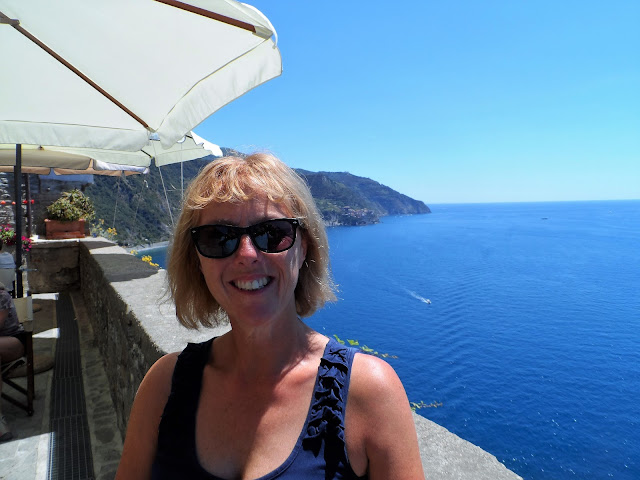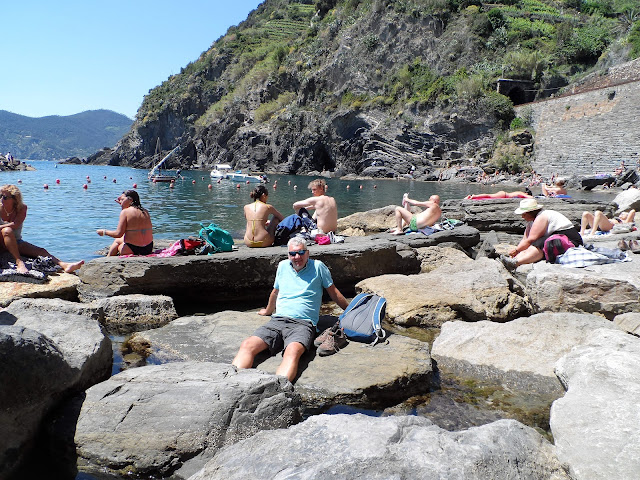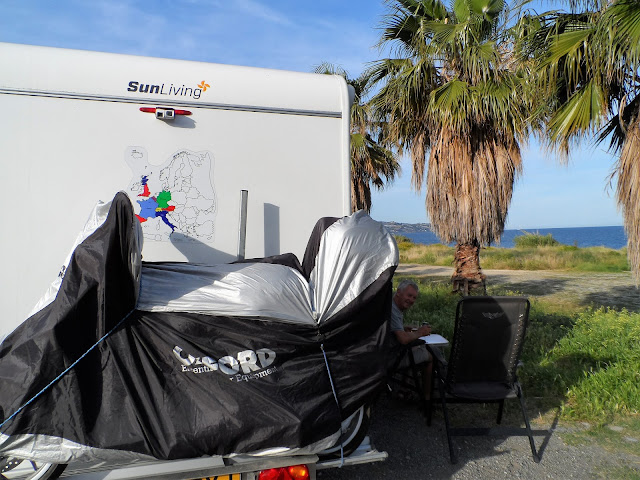We
left La Spezia and continued down the coastal road to just before Viareggio, before going on a small stretch of the autostrada to reach Lucca. Most of the way we had the sea on one side
and the backdrop of the mountains, Alpi Apuane on the other side, which are
quarried for their marble.
The
beach resorts looked overdeveloped and touristy and all the way down it has
small sections of privately owned by hotels, who charge between €20 and €25 for a
deckchair and umbrella. No such thing as ‘free beaches’ here!
Parked
up on the Sosta (N43.84028 E10.48878), it was a 5 minute walk to the old town, which is encircled
by an imposing ring of Renaissance walls crammed full of Romanesque churches. Today it is one of the wealthiest cities in
Tuscany, gained largely though silk and high-quality olive oil.
It was lovely to wander around randomly down the narrow streets and not
have to avoid crowds of tourists or tour guides!
The church of San Michele in Foro, although unfinished as the money ran out, has a beautiful façade.
 |
| San Michele in Foro |
The San Martino Cathedral
Lucca is famous for being the birth place of the composer Puccini, born in 1858.
 |
| Puccini monument on the left, and his birth house (now a museum) centre right |
Piazza Anfiteatro is a circuit of medieval buildings that was built on the
foundations of a Roman amphitheatre. We sat
and had a drink and people watched for a while.
 |
| Piazza Anfiteatro |
We then walked the city walls, which are quite wide and popular with cyclists but they
are shaded with lots of trees, which was a welcome break from the 32°C heat.
 |
| Porto San Pietro - a main gateway through the walls |
We moved on today from today from Lucca to Pisa, a short journey of only 18kms and we are parked at a Sosta at Via di Pratali (N43.72104 E10.42064) 1.5kms walk from the
town. It's €12 a night for all the usual, an extra €3 if you have electric.
 |
| Mel having a little doze at the Pisa Sosta |
The
last time we were here was in 1987 and we remember parking close by to the
leaning Tower of Pisa, getting a ticket straight away (can't remember how much), and apart from another
couple were the only ones to climb up it.
Since then a lot of restoration work has been carried to counterbalance
the leaning stonework, costing millions. and was closed from 1990 until 2001. Things are a lot different today! Parking is difficult and tickets are
extortionate - €18 per person. You get
issued an allocated time and then get in a long queue – making sure you don’t miss
your time slot, as they won’t let you up.
They only allow 30 people up at a time, for a maximum of 30 minutes and
unlike when we went up it, you can’t walk on the outside until you get to
the top. Needless to say we didn’t go up
– just did the tourist photos!
I
bought a ticket for entry into the Duomo (Cathedral) and Baptistry for €5. Mel
didn’t fancy going in (he doesn’t agree with paying to go in churches!) so took
himself off to lay on the grass in the shade, after treating himself to some imitation Ray Ban’s from a street seller.
Since being in Italy we have noticed a lot of immigrant sellers here,
who are just trying to earn a living, and there are also a lot of beggars. We gave money to one man outside Lidl in
Lucca in return for taking our trolley back, but unfortunately, we can’t give
to them all.
Work
to build the cathedral started in 1064 and took about a century to complete.
 |
| Cattedrale di Santa Maria |
A fire in 1595 meant a large part of the
interior was redecorated and parts remodelled.
They
have been carrying out further restoration work since 2015 and plan to complete
in 2018. Inside was really ornate.
The original pulpit, which was sculptured by Giovanni Pisani in 1302
The
Baptistry
 |
| Battistero di San Giovanni |
Inside is quite plain, apart from a pulpit sculptured in 1260 by Nicola Pisano (Giovanni’s father)
A lot of tourists don’t venture further than the Campo dei Miracoli (Field of
Miracles), just
coming to visit the Leaning Tower, Duomo and Baptistry. We
were no different in 1987, so this time round we got a map from the Tourist
Information and did the ‘walking routes’. But not before Mel got his photo taken with this 1951 Vespa - it is the one used in the 1953 film 'Roman holiday' with Gregory Peck and Audrey Hepburn
Piazza
dei Cavlieri – the central civic square of medieval Pisa.
Down
to the river and Ponte di Mezzo
The
town is full of old churches and building, with information in English/Italian
outside on a plaque but they are all shut up as I guess they cost too much to
keep open and get few visitors to them.
Today
has been an expensive day for us today. We had our first diesel fill-up in Italy today - €1.40 per litre! The cheapest fuel
we have found so far had been in Morocco and Andorra at €0.90, and mostly €1.12 in
France/Spain - so a big difference. We also had to buy a litre of oil for the
motorhome at €16, so with fuel, oil, sun glasses, overnight accommodation,
a day out in Pisa, we have spent 2 ½ days budget in one – ouch! Tomorrow we need to stock up on food – looks like
it might be bread and cheese for a few days ha! Ha!
Sally x





















































